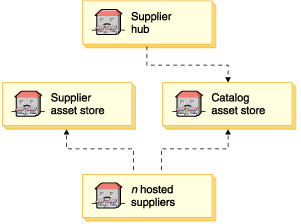Supply chain business model
A supply chain is composed of the enterprises that provide services to a business. WebSphere Commerce provides the architectural infrastructure to support supply chains that take the form of a private marketplace, as well as through supplier sites.
A private marketplace provides a forum for vendors to offer their goods and services for sale. Buyers enter this forum and after browsing through the available options, select the appropriate goods or services.
The following diagram illustrates an example of such a supplier forum.

In this example supply chain, the buyer enters the supplier's hub to interact and browse the aggregated catalog in which products and offers from multiple suppliers are presented. The buyer can then select the desired offers or request quotes from multiple suppliers. The buyer also has the option of conducting business or procuring from online suppliers directly.
Supply chain stores
The supply chain owner may create stores for its suppliers. This allows buyers to interact directly with suppliers for example, by submitting orders under pre-arranged contracts. Supplier stores can co-exist with a private marketplace so that buyers can purchase directly from their suppliers, or select suppliers through the private marketplace.
The following diagram illustrates the types of stores that compose the supply chain sample.

The supply chain sample site contains a hub (supplier hub), and two asset stores (catalog asset store and supplier asset store). Note that the supplier hub uses the assets defined in the catalog asset store. The suppliers are created by using the assets from the catalog asset store and supplier asset store.
The supplier hub owner defines the catalog taxonomy (for example the category structure, and possibly shared products and items) that the suppliers will use in the catalog asset store.
Related concepts